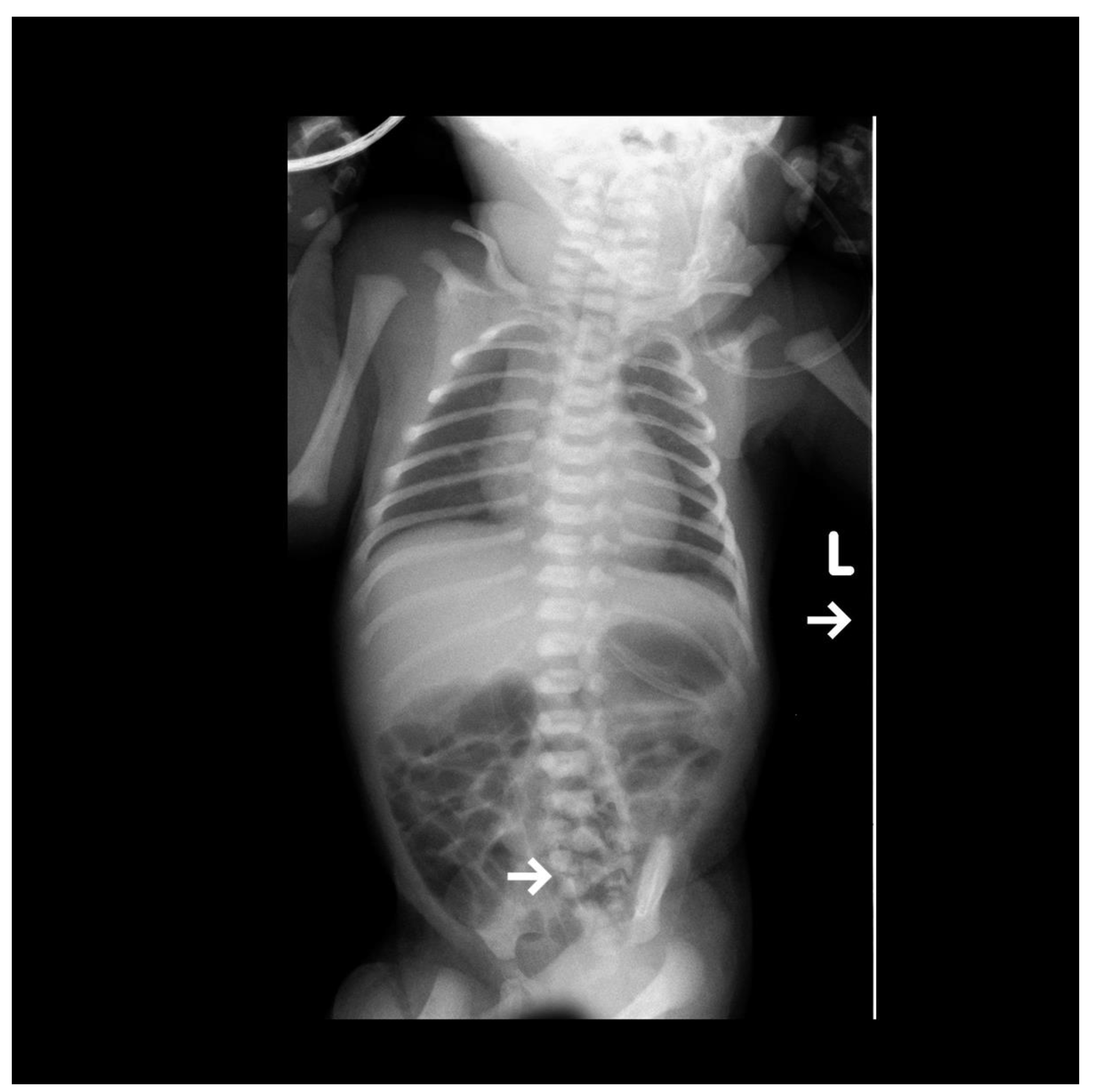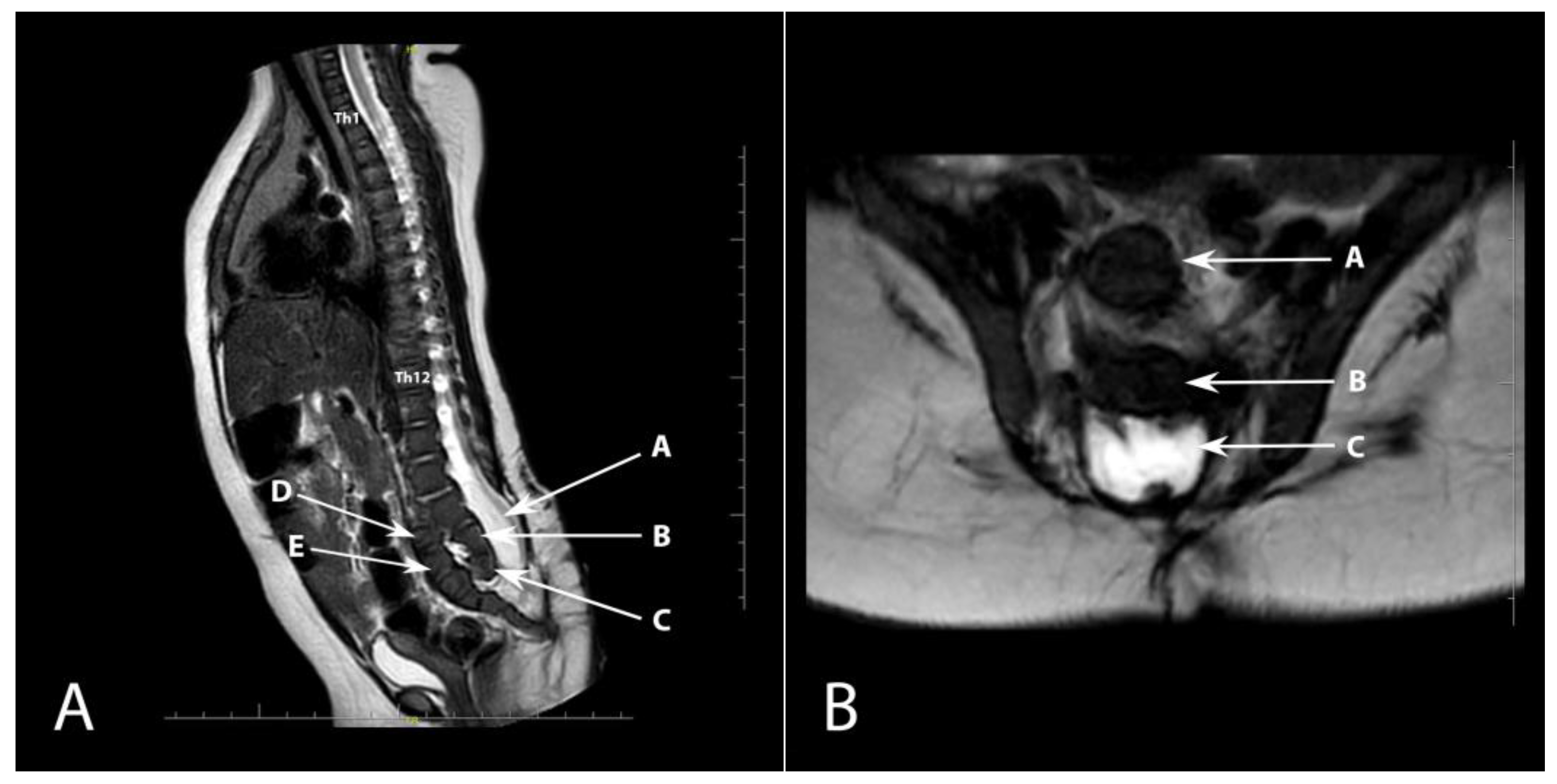Congenital Anterior Dislocation of the Sacrococcygeal Bone in a Newborn
Abstract
Author Contributions
Funding
Institutional Review Board Statement
Informed Consent Statement
Data Availability Statement
Acknowledgments
Conflicts of Interest
References
- Upasani, V.V.; Ketwaroo, P.D.; Estroff, J.A.; Warf, B.C.; Emans, J.B.; Glotzbecker, M.P. Prenatal diagnosis and assessment of congenital spinal anomalies: Review for prenatal counseling. World J. Orthop. 2016, 7, 406–417. [Google Scholar] [CrossRef] [PubMed]
- Herman, T.E.; Siegel, M.J. Type IV lumbosacrococcygeal agenesis infant of diabetic mother. J. Perinatol. 2008, 28, 163–165. [Google Scholar] [CrossRef] [PubMed]
- Zheng, Y.; Li, L.; Wang, L.; Zhang, C. The clinical value of prenatal ultrasound in the diagnosis of caudal regression syndrome. Am. J. Transl. Res. 2023, 15, 1982–1989. [Google Scholar] [PubMed]
- Currarino, G.; Coln, D.; Votteler, T. Triad of anorectal, sacral, and presacral anomalies. AJR Am. J. Roentgenol. 1981, 137, 395–398. [Google Scholar] [CrossRef] [PubMed]
- Pang, D. Sacral agenesis and caudal spinal cord malformations. Neurosurgery 1993, 32, 755–779. [Google Scholar] [CrossRef] [PubMed]
- Doursounian, L.; Maigne, J.Y.; Faure, F.; Chatellier, G. Coccygectomy for instability of the coccyx. Int. Orthop. 2004, 28, 176–179. [Google Scholar] [CrossRef] [PubMed]
- Mitchell, L.E.; Adzick, N.S.; Melchionne, J.; Pasquariello, P.S.; Sutton, L.N.; Whitehead, A.S. Spina bifida. Lancet 2004, 364, 1885–1895. [Google Scholar] [CrossRef] [PubMed]
- De-Regil, L.M.; Fernández-Gaxiola, A.C.; Dowswell, T.; Peña-Rosas, J.P. Effects and safety of periconceptional folate supplementation for preventing birth defects. Cochrane Database Syst. Rev. 2010, 10, CD007950. [Google Scholar] [CrossRef]


Disclaimer/Publisher’s Note: The statements, opinions and data contained in all publications are solely those of the individual author(s) and contributor(s) and not of MDPI and/or the editor(s). MDPI and/or the editor(s) disclaim responsibility for any injury to people or property resulting from any ideas, methods, instructions or products referred to in the content. |
© 2023 by the authors. Licensee MDPI, Basel, Switzerland. This article is an open access article distributed under the terms and conditions of the Creative Commons Attribution (CC BY) license (https://creativecommons.org/licenses/by/4.0/).
Share and Cite
Fabijan, A.; Polis, B.; Zakrzewski, K.; Zawadzka-Fabijan, A.; Korabiewska-Pluta, S.; Nowosławska, E. Congenital Anterior Dislocation of the Sacrococcygeal Bone in a Newborn. Diagnostics 2023, 13, 2108. https://doi.org/10.3390/diagnostics13122108
Fabijan A, Polis B, Zakrzewski K, Zawadzka-Fabijan A, Korabiewska-Pluta S, Nowosławska E. Congenital Anterior Dislocation of the Sacrococcygeal Bone in a Newborn. Diagnostics. 2023; 13(12):2108. https://doi.org/10.3390/diagnostics13122108
Chicago/Turabian StyleFabijan, Artur, Bartosz Polis, Krzysztof Zakrzewski, Agnieszka Zawadzka-Fabijan, Sara Korabiewska-Pluta, and Emilia Nowosławska. 2023. "Congenital Anterior Dislocation of the Sacrococcygeal Bone in a Newborn" Diagnostics 13, no. 12: 2108. https://doi.org/10.3390/diagnostics13122108
APA StyleFabijan, A., Polis, B., Zakrzewski, K., Zawadzka-Fabijan, A., Korabiewska-Pluta, S., & Nowosławska, E. (2023). Congenital Anterior Dislocation of the Sacrococcygeal Bone in a Newborn. Diagnostics, 13(12), 2108. https://doi.org/10.3390/diagnostics13122108




